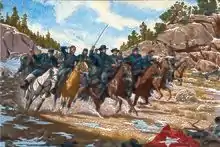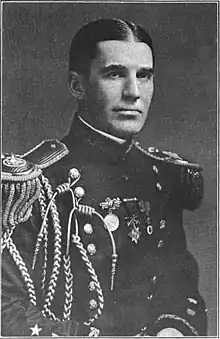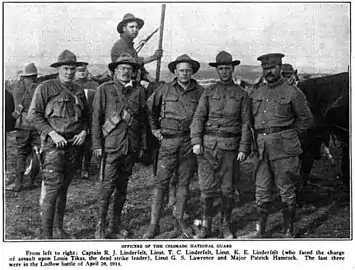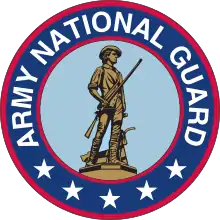Colorado National Guard
The Colorado National Guard consists of the Colorado Army National Guard and Colorado Air National Guard, forming the state of Colorado's component to the United States National Guard. Founded in 1860, the Colorado National Guard falls under the Colorado Department of Military and Veterans Affairs.[1]
| Colorado National Guard | |
|---|---|
 Logo of the Colorado National Guard | |
| Active | 1860–present |
| Country | |
| Allegiance | |
| Branch | |
| Type | National Guard |
| Role | Militia |
| Size | 5,500 |
| Part of | National Guard Bureau Colorado Department of Military and Veterans Affairs |
| Commanders | |
| Governor and Commander in Chief | Jared Polis |
| Adjutant General | Laura L. Clellan |
| Insignia | |
| Distinctive unit insignia |  |
History
Formation, Civil War, and Sand Creek
On 23 January 1860, the Jefferson Territory's legislature authorized the creation of two armed companies: the Jefferson Rangers and the Denver Guards, in part to combat the “Bummers”—a band of turkey thieves—in what was known as the “Denver City Turkey War.”[2] Disbanded shortly thereafter, the Colorado Territorial militia was created under the name "Colorado Volunteers." Coloradan soldiers participated in the American Civil War on the Union side.[3] The 1st and 2nd Colorado Infantry Regiments, serving alongside the 2nd Regiment New Mexico Volunteer Infantry and Federal cavalry, won in actions against Texan units at the Battle of Glorieta Pass in February 1862 under the leadership of former Methodist minister Colonel John Chivington. In November 1862, the 1st Colorado Cavalry Regiment was created.

Following the Hungate massacre that killed a family of four–including two children under three years old–Governor John Evans authorized the creation of the 3rd Colorado Cavalry Regiment in August 1864 to provide defense against Native Americans. The 1st and 3rd Colorado Cavalries, led by Chivington, launched an attack against an encampment of Arapaho and Cheyenne in modern-day Kiowa County in what is now known as the Sand Creek massacre. The attack killed at least 150 and up to 500 mostly unarmed Native Americans and left around thirty Colorado cavalrymen dead, some due to friendly-fire.[4] Captain Silas Soule and Lieutenant Joseph Cramer, leading Companies K and D of the 1st Colorado Cavalry, had refused the orders to attack.[5] A Joint Committee on the Conduct of the War investigation declared the Chivington had ordered and led "a foul and dastardly massacre which would have disgraced the veriest savage among those who were the victims of his cruelty."[6] However, no charges or convictions were issued by the Committee due to the previous resignations of Chivington and other officers involved.
Statehood and early mining strikes

After Colorado attained statehood in 1876, the then Colorado State Militia was occasionally activated to participate in actions in the American Indian Wars and to deal with striking miners.[3] The 1st Infantry Battalion was constituted on 8 February 1879 and organized on 29 December 1881 in Denver. The unit was redesignated as the 1st Colorado Infantry Regiment and merged with the 2nd Colorado Infantry Regiment in the last quarter of the 19th Century.[7]:1203
Three-hundred state militia under Adjutant General T.J. Tarsney were ordered by Governor Davis H. Waite in March 1894 to subdue the Cripple Creek miners' strike, led by the Western Federation of Miners (WFM). Despite some dynamiting of mines by strikers, violence was relatively low compared to later strikes in Colorado. The strike ended in June 1894.[8]
The Militia Act of 1903 reorganized the state militias and established the modern National Guard system. In March that same year, the Colorado Labor Wars began when discontented gold and silver miners, led by the WFM, went on strike throughout the state. The various groups of strikers faced opposition from strike-breakers, Pinkertons, the Baldwin-Felts Detective Agency, and the vigilante Citizens' Alliance.[8] In Idaho Springs, the strike there sought an eight-hour workday. The now National Guard was deployed to deal with the various sites of violence throughout the state. The unrest saw the deployment of around 1,000 guardsmen, equipped with 60,000 rounds of .30-40 for their Krag-Jørgensen rifles.[9]:62 Adjutant General Sherman Bell and General John Chase commanded the force, though the military district established on 4 September 1903 was headed by Colonel Edward Verdeckberg of the 1st Brigade of the guard.[10]
The National Guard would perform arrests, execute warrants, and protect mines from strikers until the military district was disestablished on 12 April 1914. During this time, Governor James H. Peabody authorized the use of lethal force to subdue the strikers, particularly near Cripple Creek.[10]:3 On 4 December 1903, the governor declared Teller County to be in a "state of insurrection and rebellion," but by 28 January 1904 had assessed that the situation to be "rapidly changing" and suspended military authority, but left the soldiers in the region for almost three more months.[10]:16–17 In March 1904, WFM offices were reported to be displaying U.S flags defaced with words "deemed of obnoxious character," which were seized and destroyed by troops.[10]:19
Colorado Coalfield War
In September 1913, after months of sporadic strikes and years of mining accidents, the United Mine Workers of America union declared a general strike in Colorado's southern counties in opposition to coal mining companies violating state laws surrounding safety, pay, and compensation. The strike targeted in particular the partially Rockefeller-owned Colorado Fuel and Iron Company (CF&I) in Huerfano, Las Animas, and Pueblo counties. After over 10,000 miners were evicted from company-owned towns across Southern Colorado in the immediate aftermath of the strike's declaration, sporadic violence began between strikers and the company-backed strikebreakers, mine guards, and deputized local militia hired by Baldwin-Felts detectives.[11][12]:266
Now Adjutant General, General John Chase was ordered by Governor Elias M. Ammons to dispatch troops to Walsenburg and other sites along the Colorado and Southern railway to disarm strikers and prevent further violence. Chase, a veteran of the 1903-1904 strikes, favored an aggressive strategy in dealing with the strikers.[13]:141 A company from the National Guard and four artillery pieces arrived in the strike zone by train on 9 October 1913 to supplement a growing local militia.[13]:117
Following the shooting deaths of several strikers by deputized horsemen in Walsenburg on 24 October, strikers, and militia engaged in a shootout in Berwind Canyon, Las Animas County. The militia was led by Karl Linderfelt, a lieutenant in the National Guard. A National Guardsman from Denver was killed by the strikers.[13]:127 Militia backed by a machine gun ultimately drove off the strikers.[12]:118 The National Guard was mobilized on 28 October and began field operations the next day, arresting strikers accused of arson and assault.[14]

On 1 November, after an agreement between General Chase and John R. Lawson, the National Guard marched between the mines and tent colonies to effect disarmament on both sides. The military report of the incident records a warm reception by the strikers, especially at Ludlow, though the National Guard only received a reported 20-30 weapons, including a toy gun, and were ultimately mocked by the strikers.[14]
In January 1914, Ammons and Chase authorized the arrest and detention of Mother Jones, a labor activist, in Trinidad. Multiple attempts by strikers and Trinidad residents to liberate her by both demonstration and riots failed. In late January, an unexploded bomb was located near the encampment of several National Guardsmen, likely in relation to these events.[14][15] After six months of having soldiers deployed to the southern part of the state and with tensions easing due to the pacifying influence of union leader Louis Tikas and the National Guard–and despite a murder in Forbes in March 1914 that saw the Guard burn a striker tent colony down–the vast majority of the troops are withdrawn back towards garrisons in Denver in mid-April 1914 to reduce cost.[14]
Ludlow Massacre


On 20 April 1914, 177 remaining Colorado National Guard troops and militia engaged in a shootout at the Ludlow tent colony, resulting in what is known as the Ludlow Massacre. Major Patrick Hamrock and Linderfelt organized the battle against the strikers, which killed around twenty on the UMWA side, including at least eleven women and children who died in a fire started by the soldiers and a boy struck by a machine gun bullet. Louis Tikas was also killed, with Linderfelt later being found responsible for his murder but was not convicted or punished by a military trial. A single National Guard soldier was killed by gunfire from the strikers.[13]:221
During the following week, strikers sought revenge against the mining companies and National Guard, launching dozens of deadly attacks across the state in what became known as the 10-Day War. General Chase immediately moved hundreds of troops back south to pacify the strikers. Captain Hildreth Frost led a small group of National Guard troops on 28 April in the northernmost battle at a nine in Louisville.[12]:197 The same day, a National Guard medic was killed and several wounded in a firefight for the hogback near Walsenburg.[12]:206 The fighting ceased on 29 April after President Woodrow Wilson ordered the federal-level Army to disarm the strikers and turn-back the National Guard. The strike concluded without much further violence in December 1914.
First World War and Interwar Period

In June 1916, prior to the United States' involvement in the First World War, the Colorado National Guard was deployed to the Mexican–American border to support General Pershing's expedition against the Mexican revolutionary Pancho Villa. The deployed troops returned in February 1917.[3]
After the National Guard was activated in 1917 to deploy to Europe to participate in the First World War, the Colorado State Defense Force was activated for the first time to take over the responsibilities of the departing Guard.[16] Called to federal service on 5 August 1917, the 1st Infantry Battalion was redesignated as the 157th Infantry Regiment on 24 September as the 157th Infantry Regiment as part of the 40th Infantry Division.[7] The 157th received campaign credit for Champagne-Marne, Aisne-Marne, St. Mihiel, Meuse-Argonne, and Champagne 1918 during their deployment to France.[17]
For much of the decade following the First World War, the Colorado National Guard was plagued with low enlistment numbers and limited funding. Despite this, it was mustered against striking Denver Tramway Company workers in August 1920, where the Guard’s limited numbers meant it was unable to effectively break up the strikers.[18]:28 In June 1921, the Arkansas River flooded, killing at least 120—with some estimates of up to 1,500 dying—and destroying hundreds of homes in and around Pueblo. The National Guard and local American Legion chapters helped rescue and recover victims.[18]:38–29[19]
The Colorado Army National Guard added the 120th Aero Observation Squadron 27 June 1923, the first unit of what would become the Colorado Air National Guard. The 120th was one the 29 original National Guard observation squadrons and was part of the 45th Division. It began flying Curtiss JN-4 Jenny biplanes out of the new Lowry Airfield in Denver in 1924.[20]
As Adjutant General, Hamrock ordered the National Guard and the state-wide police force, the Colorado Rangers, to subdue striking miners in 1922.[21][22] The National Guard was not present at the November 1927 Columbine Mine massacre, though the Colorado Rangers—which had been disbanded in April that year and were recalled up from the Guard to deal with the strike—were.[23]
On 18 April 1936, during the economic trials of the Great Depression and Dust Bowl, Governor Edwin C. Johnson declares martial law and ordered the closure of Colorado’s southern state borders to migrants. The National Guard effected this order with troops posted on the border by 20 April. Following a threatened boycott of Colorado businesses by New Mexico and New Mexican Senators Dennis Chávez and Carl Hatch condemning the measures as unconstitutional, the governor lifted his orders after only ten days.[24]
21st Century
During the COVID-19 pandemic in Colorado, the Colorado National Guard and Colorado State Patrol helped staff testing facilities.[25] With the arrival of the COVID-19 vaccines in December 2020, Brigadier General Scott Sherman was placed in charge of distribution of the vaccine in the state.[26] Due to security concerns, Colorado State Patrol were assigned to protect shipments.[27]
Units
.jpg.webp)
Army National Guard
The Colorado Army National Guard is currently composed of a variety of units, including the 169th Field Artillery Brigade (of which the 157th Field Artillery Regiment is a component), the 1st Battalion of the 157th Infantry Regiment (attached to the 10th Mountain Division), and the 117th Space Support Battalion.
Air National Guard
The Colorado Air National Guard is primarily stationed at Buckley Air Force Base in Aurora (where the F-16C/D-equipped 140th Fighter Wing is stationed).[28] The missile defense-oriented 137th Space Warning Squadron is stationed in Greeley.[28]
State Defense Force
A separate unit, the Colorado State Defense Force is a state defense force that has been mobilized twice–during the First and Second World War–which functions in lieu of the Colorado National Guard when the Guard is deployed with the Army and Air Force.[16] The state's defense force is presently inactive, though may be reactivated by the state government at any time.
References
- "Force Structure". co.ng.mil. Colorado National Guard. Retrieved 17 April 2020.
- "Colorado National Guard celebrates 160 years of service to communities, state and nation". co.ng.mil. Colorado National Guard. 22 January 2020. Retrieved 26 April 2020.
- "Heritage". co.ng.mil. Colorado National Guard. Retrieved 16 April 2020.
- Michno, Gregory F. (2004). Battle at Sand Creek. El Segundo, CA: Upton and Sons, Publishers. ISBN 978-0-912783-37-6.
- Gary L. Roberts and David Fridtjof Halaas, "Written in Blood", Colorado Heritage, Winter 2001, pp. 22–32.
- "United States Congress Joint Committee on the Conduct of the War, 1865 (testimonies and report)". University of Michigan Digital Library Production Service. Retrieved 16 April 2020.
- McKenney, Janice E. (2010). Field Artillery: Regular Army and Army Reserve, Part 2 (Army Lineage Series) (PDF). CMH Pub 60-11. Washington, D.C.: Center of Military History. OCLC 275151269.
- Suggs, Jr., George G. Colorado's War on Militant Unionism: James H. Peabody and the Western Federation of Miners. 2nd ed. Norman, OK: University of Oklahoma Press, 1991. ISBN 0-8061-2396-6
- All That Glitters: Class, Conflict, and Community in Cripple Creek, Elizabeth Jameson, 1998.
- Edward Verdeckberg (1904). Report on the Operations and Administration of the Troops of the First Brigade, National Guard of Colorado, On Duty in the Cripple Creek Mining District From September 4th, 1903 to April 12th, 1904 (Report). Denver Public Library.
- Boor Tonn, Mari (2011). ""From the Eye to the Soul": Industrial Labor's Mary Harris "Mother" Jones and the Rhetorics of Display". Rhetoric Society Quarterly. 41 (3): 231–249. doi:10.1080/02773945.2011.575325. JSTOR 23064465. S2CID 144700584.
- Martelle, Scott (2007). Blood Passion: The Ludlow Massacre and Class War in the American West. Rutgers University Press. ISBN 978-0-8135-4419-9.
- McGovern, George Stanley; Guttridge, Leonard F. (1972). The Great Coalfield War. Boston: Houghton Mifflin. ISBN 0395136490. OCLC 354406.
- Colorado Adjutant General's Office (1914). The Military Occupation of the Coal Strike Zone of Colorado by the National Guard, 1913-1914 (Report).
- Sunseri, Alvin (1972). "The Ludlow Massacre: A study in the mis-employment of the National Guard". University of Northern Iowa. Cite journal requires
|journal=(help) - Tulenko, Thomas; Chase, Bradley; Dupuy, Trevor N.; Hayes, Grace P. (March 1981). "US Home Defense Force Study" (PDF). California Military Museums. Historical Evaluation and Research Organization. Retrieved 18 April 2020.
- "Department of the Army Lineage and Honors: 157th Infantry Regiment". Department of the Army Lineage and Honors. Department of the Army. Retrieved 26 April 2020.
- "Historic Resources of Camp George West, Golden, Colorado" (PDF). National Register of Historic Places Multiple Property Documentation Form. History Colorado. 1 September 1992. Retrieved 15 August 2020.
- Sommariva, Kelly (2 June 2014). "THIS WEEK IN 1921: THE FLOOD THAT NEARLY SANK PUEBLO". Retrieved 15 August 2020.
- "120th Fighter Squadron". NATO Tigers. Retrieved 26 April 2020.
- "Official National Guard Register, 1922". 1922. Retrieved 25 April 2020.
- "RANGERS TO DRIVE UNION AGITATORS OUT". Fort Collins Courier. 10 April 1922. Retrieved 29 November 2019.
- "Colorado Rangers, Abolishment" (PDF). William A. Wise Law Library. 1 April 1927. Archived from the original (PDF) on 31 August 2018. Retrieved 25 April 2020.
- Allen, Taylor (11 September 2019). "In 1936, Colorado Closed Its Southern Border To Certain Migrants — For 10 Days". Colorado Public Radio News. Retrieved 25 April 2020.
- Ziegler, Susie. "State of Colorado opens Weld County testing facility for any resident with symptoms of COVID-19". Retrieved April 25, 2020.
- Matt Moret; Chuck Murphy (14 December 2020). "The First Coronavirus Vaccine Doses Arrived In Colorado Monday. Here's What We Know". CPR.org. Colorado Public Radio. Retrieved 15 December 2020.
- Paul, Jesse (15 December 2020). "Colorado's final coronavirus vaccine preparations include practicing for high-stakes delivery road trips". The Colorado Sun. Retrieved 11 December 2020.
- "140th Wing Factsheet". www.ang.af.mil. United States Air Force. Archived from the original on 2012-09-07.




